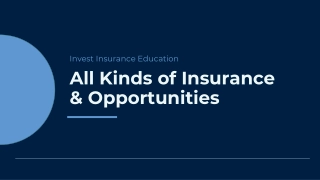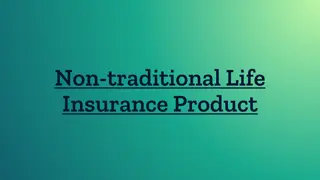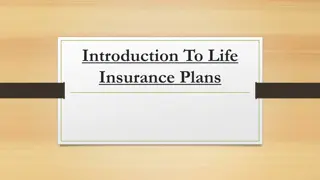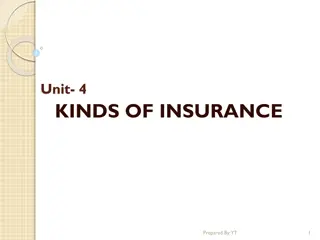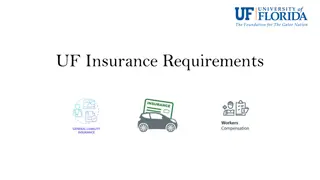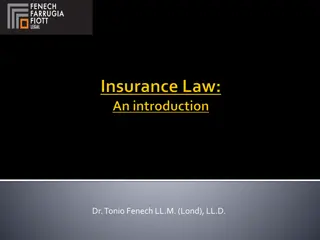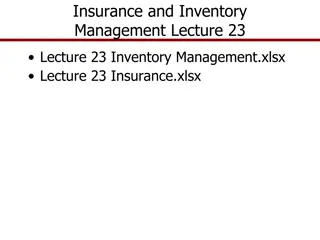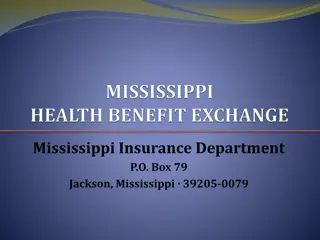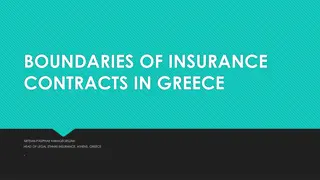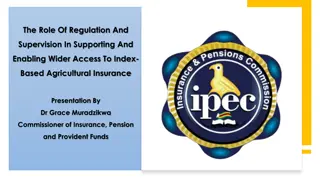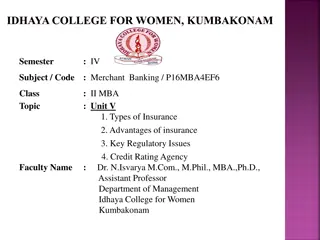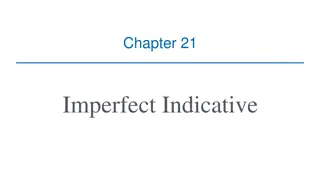Insurance and Imperfect Information
Insurance provides protection from unexpected events by pooling funds from premiums. Imperfect information in insurance arises from uncertainty about future events and individuals' characteristics or choices. Insurance companies negotiate lower rates, benefitting both consumers and the company's financial flow.
Download Presentation

Please find below an Image/Link to download the presentation.
The content on the website is provided AS IS for your information and personal use only. It may not be sold, licensed, or shared on other websites without obtaining consent from the author.If you encounter any issues during the download, it is possible that the publisher has removed the file from their server.
You are allowed to download the files provided on this website for personal or commercial use, subject to the condition that they are used lawfully. All files are the property of their respective owners.
The content on the website is provided AS IS for your information and personal use only. It may not be sold, licensed, or shared on other websites without obtaining consent from the author.
E N D
Presentation Transcript
HAWKES LEARNING Insurance and Imperfect Information
Insurance and Imperfect Information Insurance provides an individual or business with protection from the economic effects of an unexpected event.
Introduction Insurance is a method that households and firms use to prevent any single event from having a significant detrimental financial effect. Generally, households or firms with insurance make regular payments, called premiums. The insurance company prices these premiums based on the probability of certain events occurring among a pool of people. Members of the group who then suffer a specified bad experience receive payments from this pool of money.
Imperfect Information All insurance involves imperfect information. We cannot predict future events with certainty. Adverse events occur due to a combination of people s characteristics and choices, which make the risks higher or lower, and the good or bad luck of circumstances.
How Insurance Works 60 drivers: small dings 10 drivers: major accidents $186,000 in claims = $1,860 premium for each driver 30 drivers: medium-sized accidents 100 drivers Since insurance companies have such a large number of clients, they are able to negotiate with health care and other service providers for lower rates than the individual would be able to get. This both increases the benefit to consumers of becoming insured and saves the insurance company money when it must pay claims.
How Insurance Companies Make Money Money In: Premiums from customers Investment income Money Out: Payments to customers Expenses Profits or losses Insurance Company Money flows into an insurance company through premiums and investments and out through the payment of claims and operating expenses.
Government and Social Insurance Federal and state governments run a number of insurance programs. Government Insurance Programs Type of Insurance Who Pays for It? It Pays Out When Unemployment insurance Employers Workers lose their jobs and cannot find new ones Pension insurance Employers pay into the Pension Benefit Guarantee Corporation Companies go bankrupt and cannot pay pension benefits promised to workers Deposit insurance Banks pay into the Federal Deposit Insurance Corporation Banks go bankrupt; it pays depositors up to $250,000 Workers compensation insurance Employers pay into state funds Workers suffer an injury on the job Retirement insurance (Social Security and Medicare) Workers pay a percentage of their income into the Social Security fund and Medicare fund Workers retire and when retired workers need health care
Risk Groups To make insurance fair, customers are often divided into risk groups, where the people in the group share roughly the same risks of something bad happening. High-risk group pays higher premium. Low-risk group pays lower premium. If someone is generally safe and has one major accident, which group should they be in?
Actuarially Fair When the premiums paid equal the amount an average person in that risk group would collect in the payout of claims, the level of insurance is said to be actuarially fair.
Moral Hazard Problem Moral hazard refers to the case when people with insurance engage in riskier behavior than they would if they did not have insurance. Ways to Reduce Effects Discounts on premiums for safety measures Requiring customer to pay share of the costs Monitoring behavior
Ways Customers Pay Copayments: Deductibles: the policyholder pays a small amount, and the insurance company pays the rest the amount the policyholder pays before insurance starts paying Coinsurance: the insurance company pays a certain percentage, and the policyholder pays the rest
Incentives of Health Care Providers Fee-for-service: health care providers are paid for the services they provide and are paid more if they provide more services HMOs: health care providers are paid a fixed amount per person, which gives the provider the incentive to limit the quantity of care
Adverse Selection Problem Adverse selection refers to the problem in which insurance buyers have more information about whether they are high-risk or low-risk than the insurance company does. Buyers who are high-risk tend to want to buy more insurance without letting the insurance company know about their higher risk. For example, someone purchasing health insurance probably knows more about their family's health history than an insurer can find out.
U.S. Health Care in an International Context The U.S. is the only high-income country where private firms pay and provide for most health insurance. The U.S. spends more per capita on health care than any other industrialized country. Outcomes measured by life expectancy and child mortality are worse than in other high-income countries. The U.S. health care system provides high-quality care with relatively short waiting times for treatment. Other countries have more equal access, but quality may be lower and waiting times longer than in the U.S.
Government Regulation of Insurance The U.S. insurance industry is primarily regulated at the state level. The National Association of Insurance Commissioners brings together these state regulators to exchange information and strategies. The state insurance regulators attempt to keep the price of insurance low and ensure that everyone has insurance. If premiums are set low for all policyholders, the premiums collected may not be enough to cover all the claims. If premiums are set too low, insurance companies will lose money and withdraw from the insurance markets in that state.
Government Regulation of Insurance In some industries, the U.S. government has decided free markets will not provide insurance at an affordable price, so the government pays for it directly. Another common government intervention in insurance markets is to require that everyone buy certain kinds of insurance. States require car insurance Mortgage companies require homeowner's insurance Medicaid Medicare
The Patient Protection and Affordable Care Act In March of 2010, President Obama signed into law the Patient Protection and Affordable Care Act (PPACA). The goal of the act is to bring the United States closer to universal coverage. Prior to the ACA, more than 32 million Americans were uninsured. People who are uninsured tend to use emergency rooms for treatment, which has contributed significantly to rising costs.
On Your Own This lesson discusses the tradeoff between quality of care and equal access at low costs. Which do you consider to be more important, a high quality of care provided or more equal access and lower costs? Why? HAWKES LEARNING
Summary The fundamental law of insurance is that what the average person pays in over time cannot be less than what the average person gets out. Many insurance policies have deductibles, copayments, or coinsurance. In a fee-for-service health financing system, medical care providers receive reimbursement according to the cost of services they provide. An alternative method of organizing health care is through health maintenance organizations (HMOs), where medical care providers receive reimbursement according to the number of patients they handle, and it is up to the providers to allocate resources between patients who receive more or fewer health care services. Adverse selection arises in insurance markets when insurance buyers know more about the risks they face than the insurance company. HAWKES LEARNING


